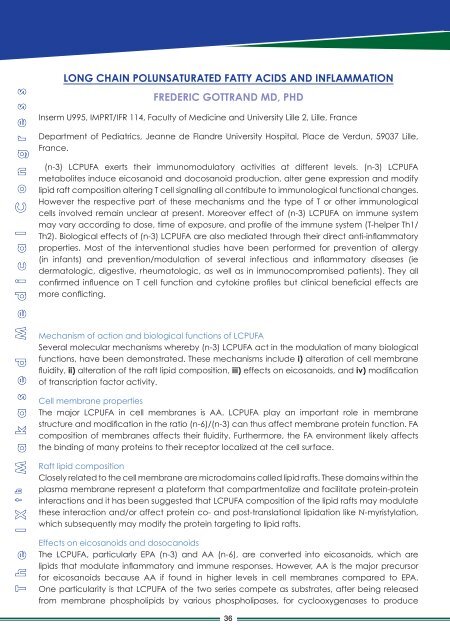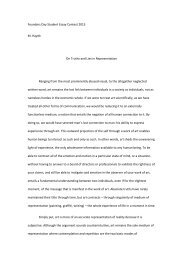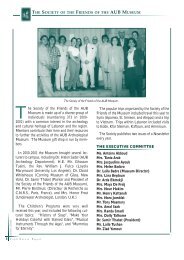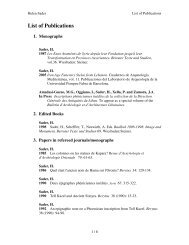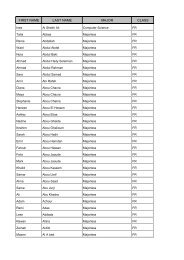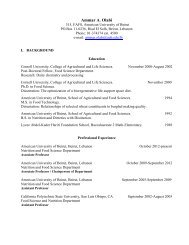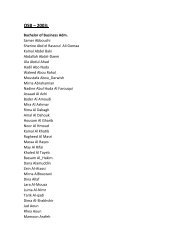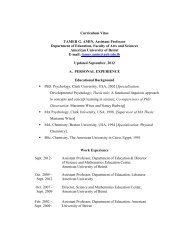The IX t h Makassed Medical Congress - American University of Beirut
The IX t h Makassed Medical Congress - American University of Beirut
The IX t h Makassed Medical Congress - American University of Beirut
You also want an ePaper? Increase the reach of your titles
YUMPU automatically turns print PDFs into web optimized ePapers that Google loves.
T h e I X t h M a k a s e d M e d i c a l C o n g r e s s<br />
LONG CHAIN POLUNSATURATED FATTY ACIDS AND INFLAMMATION<br />
FREDERIC GOTTRAND MD, PHD<br />
Inserm U995, IMPRT/IFR 114, Faculty <strong>of</strong> Medicine and <strong>University</strong> Lille 2, Lille, France<br />
Department <strong>of</strong> Pediatrics, Jeanne de Flandre <strong>University</strong> Hospital, Place de Verdun, 59037 Lille,<br />
France.<br />
(n-3) LCPUFA exerts their immunomodulatory activities at different levels. (n-3) LCPUFA<br />
metabolites induce eicosanoid and docosanoid production, alter gene expression and modify<br />
lipid raft composition altering T cell signalling all contribute to immunological functional changes.<br />
However the respective part <strong>of</strong> these mechanisms and the type <strong>of</strong> T or other immunological<br />
cells involved remain unclear at present. Moreover effect <strong>of</strong> (n-3) LCPUFA on immune system<br />
may vary according to dose, time <strong>of</strong> exposure, and pr<strong>of</strong>ile <strong>of</strong> the immune system (T-helper Th1/<br />
Th2). Biological effects <strong>of</strong> (n-3) LCPUFA are also mediated through their direct anti-inflammatory<br />
properties. Most <strong>of</strong> the interventional studies have been performed for prevention <strong>of</strong> allergy<br />
(in infants) and prevention/modulation <strong>of</strong> several infectious and inflammatory diseases (ie<br />
dermatologic, digestive, rheumatologic, as well as in immunocompromised patients). <strong>The</strong>y all<br />
confirmed influence on T cell function and cytokine pr<strong>of</strong>iles but clinical beneficial effects are<br />
more conflicting.<br />
Mechanism <strong>of</strong> action and biological functions <strong>of</strong> LCPUFA<br />
Several molecular mechanisms whereby (n-3) LCPUFA act in the modulation <strong>of</strong> many biological<br />
functions, have been demonstrated. <strong>The</strong>se mechanisms include i) alteration <strong>of</strong> cell membrane<br />
fluidity, ii) alteration <strong>of</strong> the raft lipid composition, iii) effects on eicosanoids, and iv) modification<br />
<strong>of</strong> transcription factor activity.<br />
Cell membrane properties<br />
<strong>The</strong> major LCPUFA in cell membranes is AA. LCPUFA play an important role in membrane<br />
structure and modification in the ratio (n-6)/(n-3) can thus affect membrane protein function. FA<br />
composition <strong>of</strong> membranes affects their fluidity. Furthermore, the FA environment likely affects<br />
the binding <strong>of</strong> many proteins to their receptor localized at the cell surface.<br />
Raft lipid composition<br />
Closely related to the cell membrane are microdomains called lipid rafts. <strong>The</strong>se domains within the<br />
plasma membrane represent a plateform that compartmentalize and facilitate protein-protein<br />
interactions and it has been suggested that LCPUFA composition <strong>of</strong> the lipid rafts may modulate<br />
these interaction and/or affect protein co- and post-translational lipidation like N-myristylation,<br />
which subsequently may modify the protein targeting to lipid rafts.<br />
Effects on eicosanoids and dosocanoids<br />
<strong>The</strong> LCPUFA, particularly EPA (n-3) and AA (n-6), are converted into eicosanoids, which are<br />
lipids that modulate inflammatory and immune responses. However, AA is the major precursor<br />
for eicosanoids because AA if found in higher levels in cell membranes compared to EPA.<br />
One particularity is that LCPUFA <strong>of</strong> the two series compete as substrates, after being released<br />
from membrane phospholipids by various phospholipases, for cyclooxygenases to produce<br />
36


